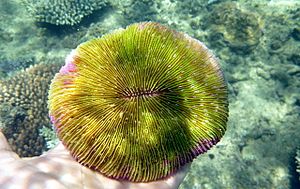Danafungia scruposa facts for kids
Quick facts for kids Danafungia scruposa |
|
|---|---|
 |
|
| Danafungia scruposa, Russell Island (Frankland Islands) | |
| Scientific classification | |
| Synonyms | |
|
List
|
Danafungia scruposa is a special type of coral. It is the first coral ever seen eating jellyfish! This amazing coral was first described in 1879. It can grow to about 25 centimeters (10 inches) wide. Scientists consider it a "least concern" species. This means it is not currently in danger of disappearing.
Contents
About This Coral
Danafungia scruposa is quite large for a single coral animal. It can be up to 25 centimeters (10 inches) across. Most corals are made of many tiny animals called polyps. But this coral is unusual because it is just one big polyp.
Normally, this coral eats very small things. Its diet includes tiny bacteria and small animals called mesozooplankton. These are usually less than 1 millimeter (0.04 inches) in size.
A Surprising Meal
In 2009, something amazing happened. Researchers were watching the coral during an algal bloom. An algal bloom is when tiny ocean plants grow very quickly. During this time, they saw the coral eating jellyfish! The jellyfish it ate was called Aurelia aurita, also known as the moon jellyfish.
This was the first time anyone had ever seen a coral eat a jellyfish in the wild. Scientists are still not sure how the coral catches these bigger prey. It might use its tentacles, like some sea anemones do. Sea anemones are close relatives of corals.
What It Looks Like
The single polyp of Danafungia scruposa can be up to 240 millimeters (9.4 inches) wide. It can be oval or round in shape. This coral often has special parts called tentacular lobes. It also has many dense septa, which are plate-like structures. Its color can be blue or brown. The largest ones found have been around 38 centimeters (15 inches) across.
Where It Lives
Danafungia scruposa can be found in many warm ocean areas. It lives in the Indian Ocean, both east and west. You can also find it in the Pacific Ocean, including the eastern central, northwestern, and western central parts. It lives near Japan, in the East China Sea, and the Red Sea. It is also found off the coast of eastern Australia.
This coral usually lives on the slopes of coral reefs. It prefers depths between 1 and 27 meters (3 to 88 feet) underwater. Scientists believe it is a common species, even though exact numbers are not known.
Threats to the Coral
Like many corals, Danafungia scruposa faces several threats. A study in 1991 showed that many of these corals were bleached. Coral bleaching happens when corals get stressed, often by warm water. They lose their color and can die.
Other dangers include diseases, climate change, and fishing activities. Predators also hunt them. Human activities can also harm their habitats. Despite these threats, the International Union for Conservation of Nature (IUCN) lists Danafungia scruposa as a "least concern" species. This means it is not currently at high risk of extinction.
How It Was Named
This coral was first described by a scientist named Klunzinger in 1879. He originally named it Fungia scruposa. It is also known by another scientific name, Fungia corona.

